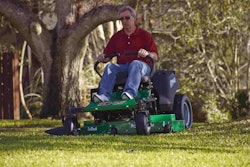
A lawn can turn brown at the first sign of stress, whether that would be from over-watering or drought. If the lawn is mowed too low, the roots haven’t been established to pull water from the soil.
“Typically, you want to mow the lawn 2½ -3 inches long,” says Mark Sodja, outdoor power equipment specialist, eReplacementParts.com. “A lot of people like to mow their lawn really low. Yeah, it makes for a great looking lawn, but it doesn’t promote a healthy root system.”
If the lawn begins to brown, it needs to be watered, but Sodja says over-watering is just as dangerous as not watering. “Obviously, you can water too much,” Sodja says. “That doesn’t promote a healthy root system. If you’re watering excessively, like way too long every night, that water is going to stay on the surface of most soils.”
If the roots are only an inch or inch and a half into the ground, the lawn will dry out through periods of drought in the summer months.
Digging in
Determining what type of soil is the first step in factoring how much water is needed.
“If you have a heavy clay soil like we have in Utah, the water will stay in the soil a lot longer,” Sodja says. “If it’s sandy, water two or three times a day if you have water restrictions. It will take the maximum amount of water.”
Water becomes a little trickier as drought comes and goes through the hotter months. In drought areas, Sodja says make the mow height at least 3 inches, because the water will be retrained ultimately keeping the lawn healthy and creating a larger capacity to store water.
Going native
Depending on the region of the country dictates the type of native grasses in the area.
Rye grasses are found up North, bluegrass if found in the West and Midwest and Bermuda grass is found down South.
“A lot of people avoid native grasses, because they’re not familiar with them,” Sodja says. “They do have different looks, but if you plant native grass, when you get to the drought times, it’s used to those types of conditions, and in drought or water restrictions, it’ll do better for you.”
Timing is everything
No matter how big a fleet may be, creating a maintenance schedule and sticking to that schedule will make a big difference through the busy season.
Waiting until the mower breaks could leave a company stranded for weeks without a key piece of equipment needed during the busiest time. “It’s the pit that people fall into, and they either don’t do the maintenance or wait until something goes wrong, and at that point it’s too late,” Sodja says.
The three biggest factors to address are changing the oil according to the engine manufacturers (typically about every 590 hours), changing the air filter and changing the spark plug about once a year as needed.
“Just get organized with a spreadsheet with each mower and what you have done on that mower,” Sodja says. “With a big fleet, it helps to have everything on the same schedule so that you’re doing your walk behinds together, your riders together and your stand-ons together.”
Buying equipment from the same manufacturer can help cut costs and downtime. “As you build a fleet, take a hint from the airlines and stick with the same models of brands, so you’re not buying different parts from different sources,” Sodja says. “It’s much less expensive and easier to maintain the inventory.”









